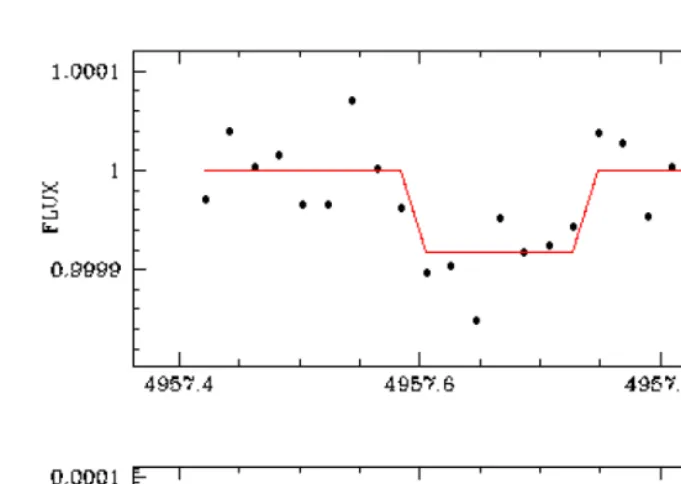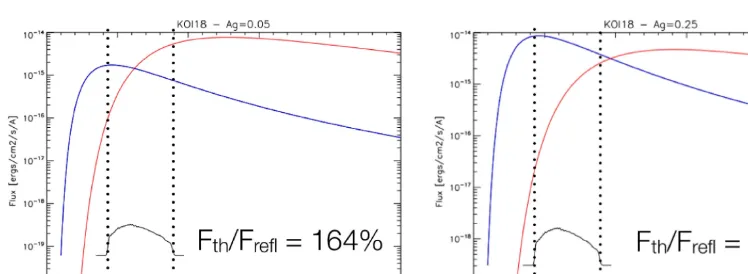Hot Jupiter secondary eclipses measured by
Kepler
B.-O. Demory
1& S. Seager
11
Department of Earth, Atmospheric and Planetary Sciences, Massachusetts
Institute of Technology, Cambridge, USA [demory@mit.edu]
Abstract.
Hot-Jupiters are known to be dark in visible bandpasses, mainly
be-cause of the alkali metal absorption features. The outstanding quality of the
Kepler
mission photometry allows a detection (or non-detection upper limits on) giant
planet secondary eclipses at visible wavelengths. We present such measurements
on published planets from Kepler Q1 data. We then explore how to disentangle
between the planetary thermal emission and the reflected light components that
can both contribute to the detected signal in the Kepler bandpass. We finally
in-vestigate how different physical processes can lead to a wide variety of hot-Jupiters
albedos.
1.
Background and motivation
Secondary eclipses of two dozen transiting hot-Jupiters have been observed at infrared
wavelengths with the
Spitzer
Space Telescope so far (see, e.g., Seager & Deming 2010).
These strongly irradiated planets efficiently absorb visible light from their host stars
and exhibit temperatures that largely exceed 1000K. The hot Jupiters consequently
produce infrared emission signature of the order of 10
−3as compared to the host star
flux.
The reflected light component of the hot-Jupiter population is critical to
con-strain planetary energy budgets and to explore the upper atmosphere properties. While
Jupiter has a geometric albedo of 0.5 in the visible, HD209458b’s geometric albedo is
surprisingly low :
<
0.08 (3-
σ
upper limit, Rowe et al. 2008). Establishing a survey
of secondary eclipses in the visible is thus highly desirable to better understand the
origins of such diversity.
Table 1 summarizes visible band geometric albedo measurements that have been
obtained to date. Hot Jupiters are dark, due to the alkali metal (Na and K) line
absorption and possibly due to TiO and VO strong molecular absorption bands in the
visible (e.g. Seager & Sasselov 2000, Marley et al. 1999, Sudarsky et al. 2000, 2003).
The planetary to stellar flux ratio of hot Jupiters at visible wavelengths is of the
order of 10
−5, making it very challenging to measure (see Fig.1). After just 1.5 years
of operation,
Kepler
has proven to be a facility able to achieve a few parts per million
(ppm) photometric precision (e.g. Jenkins et al., 2010). We present an overview of
secondary eclipse measurements for published
Kepler
giant planets and explore the
possible origins of the signature measured in visible wavelengths.
© Owned by the authors, published by EDP Sciences, 2011 DOI:10.1051/epjconf/20111103005
EPJ Web of Conferences 11, 03005 (2011) 11
Figure 1: Approximate spectral energy distribution for the Sun, Jupiter, Venus, Mars, the Earth and a representative hot Jupiter. Both thermal and reflected components are plotted for each planet. Bandpasses of Kepler and Spitzer are indicated, showing which wavelength region of the planetary spectra are probed. Adapted from Seager 2003.
2. Geometric albedo determination
We performed Markov Chain Monte-Carlo analyses on the 6 hot Jupiters that have been observed by Kepler, including two previously known exoplanets : TrES-2b and HAT-P-7b. Public data from the first quarter were used to derive the systems parameters. Geometric albedos were computed from the secondary eclipse depth, planetary radius, and semi-major axis (eq. 1, Lopez-Morales & Seager 2007). The geometric albedo is wavelength-dependent and measures the ratio of the planet flux at zero phase angle to the flux from a Lambert sphere at the same distance and the same cross-sectional area as the planet (see Seager 2010).
Fp F⋆
=Ag
Rp a
2
(1)
The photometric precision ofKepler is illustrated in Fig. 2, where a single, 80 ppm secondary eclipse of HAT-P-7b is shown and clearly detected. Results from this prelim-inary study appear in Table 2 and depict a wide variety of geometric albedos, ranging from 0.06 to 0.35. Such analysis has been performed by Kipping &Bakos (2010) and results show good consistency with those presented here.
Detection and Dynamics of Transiting Exoplanets
Table 1: Published constraints on hot Jupiters geometric albedos measured in the visible.
Planet Geometric Albedo Teq Reference
[K]
τ Bootis b 0.32±0.13 (RP=1.2RJ up) ∼1500K Leigh et al. 2003a
” <0.3 (RP=1.2RJ up) ” Charbonneau et al. 1999
HD75289 <0.12 (3-σ upper limit) 1260 Leigh et al. 2003b HD209458b <0.08 (3-σ upper limit) 1550 Rowe et al. 2008 CoRoT-1b <0.20 (3-σ upper limit) 2330 Snellen et al. 2010
CoRoT-2 0.06±0.06 1910 Alonso et al. 2010
Table 2: Geometric albedos and equilibrium temperatures (assuming no redistribution) for Kepler published giant planets from public data (Q1).
Planet Geometric Albedo Teq
[K]
Kepler 5b 0.21±0.10 1557
Kepler 6b 0.18± 0.09 1411
Kepler 7b 0.35± 0.11 1370
Kepler 8b 0.21± 0.10 1567
TrES-2b 0.06± 0.05 1464
HAT-P-7b 0.20± 0.03 2085
3. Disentangling thermal emission and reflected light
As illustrated in Fig. 3 with the case of Kepler-5b, hot-Jupiter thermal emission could have a significant contribution to the planetary flux measured in theKepler bandpass. While most of those planets do not benefit from a known effective temperature, one has to rely on an estimate of possible equilibrium temperature domain, through an estimation of both redistribution factorf and Bond albedoAB (see eq. 2).
Tp=T⋆
R⋆ a
1 2
[f(1−AB)] 1
4 (2)
Figure 2: Top: Kepler single long-cadence (30min) secondary eclipse lightcurve of the 2.2-day period hot Jupiter HAT-P-7b with the best fit model superimposed. 1-σ error bars are also indicated. Bottom : residuals of the fit. The occultation depth is 82 ± 12 ppm. Obtained from Kepler Q1 public data, 190 ppm rms /min.
4. Conclusions
TheKepler mission will allow a comparative study of hot Jupiter secondary eclipses in the visible. Disentangling thermal emission from reflected light components is a critical point to address. While alkali metal absorption lines and TiO and VO molecular absorption bands are expected to shape the spectrum of hot Jupiters in the Kepler
bandpass, the planetary thermal emission is arguably an important contributor for the most irradiated hot-Jupiters. Additionally, clouds are expected to form at the intersection of enstatite and iron compound condensation curves with the planetary temperature structure profile. The altitude of iron and enstatite cloud decks in hot Jupiter atmospheres significantly affects the geometric albedo. How representative are giant irradiated planets harboring high altitude reflective clouds and hazes is one of the several points Kepler will be able to address, shedding light on the properties of hot Jupiter atmospheres.
Detection and Dynamics of Transiting Exoplanets
Figure 3: Thermal (red) vs. reflected (blue) components in the Kepler bandpass for a 3.5-day period and 1.4RJ up hot Jupiter. The low geometric albedo case (left) assumes Ag=0.05, consistent with the value determined for HD209458b by Rowe et al. 2008.
The high geometric albedo case (right) explores the relative contribution of thermal and reflected fluxes for a highly irradiated and reflective hot Jupiters (e.g. Sudarsky et al. 2000) with Ag=0.40. A Lambertian sphere with no energy redistribution (f=2/3,
see Lopez-Morales & Seager 2007) are assumed (the radiative timescale is in this case shorter than the advective timescale). To estimate the planetary equilibrium tempera-ture, the Bond albedo is computed from the geometric albedo as AB = 32 Ag. Ratios
of planetary thermal flux to reflected flux in the Kepler bandpass are indicated for each case.
References
Alonso, R., Guillot, T., Mazeh, T., Aigrain, S., Alapini, et al., 2009, in A&A, 501, L23 Charbonneau, D., Noyes, R. W., Korzennik, S. G., Nisenson, P., Jha, S., Vogt, S. S. & Kibrick,
R. I. 1999 in ApJ, 522, L45
Jenkins, J. M., Caldwell, D. A., Chandrasekaran, H., Twicken, J. D., Bryson, S. T., et al., 2010, in ApJ, 713, L120
Kipping, D. M. & Bakos, G. A. 2010, astro-ph.EP, 1004.3538
Leigh, C., Collier Cameron, A., Horne, K., Penny, A. & James, D., 2003a, in MNRAS, 344, 1271
Leigh, C., Collier Cameron, A., Udry, S., Donati, J-F., Horne, K., James, D. & Penny, A. 2003b, in MNRAS, 346, L16
L´opez-Morales, M. & Seager, S. 2007, in ApJ, 667, L191
Marley, M. S., Gelino, C., Stephens, D., Lunine, J. I. & Freedman, R. 1999 in ApJ, 513, 879 Rowe, J. F. Matthews, J. M., Seager, S., Miller-Ricci, E., Sasselov, D., et al., 2008, in ApJ,
689, 1345
Seager, S. & Deming, D. 2010, in ARA&A, 48, 631
Seager, S. 2010, Exoplanet Atmospheres: Physical Processes (Princeton University Press) Seager, S. & Sasselov, D. D. 2000, in ApJ, 537, 916
Seager, S. 2003, in Earth and Planetary Science Letters, 208, 113
Snellen, I. A. G., de Mooij, E. J. W. & Albrecht, S. 2010, in Nature, 459, 543 Sudarsky, D., Burrows, A. & Pinto, P. 2000, in ApJ, 538, 885



